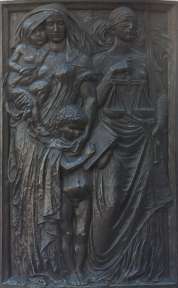 Panel on the General Gordon Monument, by Hamo Thornycroft
Panel on the General Gordon Monument, by Hamo Thornycroft
The Victoria Embankment was built in 1864-70, providing a pleasant walkway alongside the River Thames, but at the cost of considerably diminishing the width of the river. The architect was Joseph Bazalgette. Starting from the Houses of Parliament (Westminster tube, Parliament Square), a good walk may be made along the river, through the green spaces on either side of Embankment Station, and then along the busy road to Blackfriars, with the opportunity to see along the way more than 40 works of sculpture of greater and lesser worth.
All along the embankment, the excellent lampstands, with their dolphins, designed by the architect G. Vulliamy, and modelled by C. H. Mabey. Also the benches, with their single-legged busty sphinxes, which again go all the way along, but right at the end turn to camels. And the streetlamps, which I feel some affection for.
From Parliament Square, start with Thomas Thornycroft’s Boadicea. There is a fine view across the river, where one can clearly see the massive Coade stone lion, by W.F. Woodington. Starting along the Embankment, we immediately pass New Scotland Yard, by the important architect Richard Norman Shaw, and bearing a little panel of him designed by Lethaby and modelled by Hamo Thornycroft, son of Thomas, and who we shall meet again in a full size work in a moment.
 Panel on the General Gordon Monument, by Hamo Thornycroft
Panel on the General Gordon Monument, by Hamo Thornycroft
Next, the Ministry of Defence, which has directly in front of it the Chindit Memorial, other modern works, and on the opposite side of the road at the nearer end the rather new Battle of Britain monument, with lots of active figures. Across the river is the immense sweep of the old GLC building, with sculpture too small to appreciate from this side. Back in front of the MOD, the last statue, and of great interest, is of General Gordon, the promised work by Hamo Thornycroft. A fine portrait statue. With Thornycroft, though, we are most familiar with allegorical girls, and so we reproduce here one of the two nice panels on either side of the base of the monument.
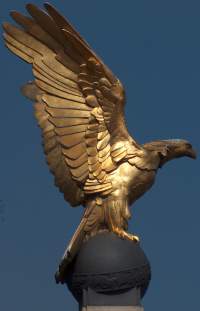 Royal Air Force Monument, by William Reid Dick
Royal Air Force Monument, by William Reid Dick
On the other side of the road is the great Eagle up on a tall column which forms the memorial to the Royal Air Force, by William Reid Dick, and the architect Reginald Blomfield, dating from 1923.
Crossing over Horseguards Avenue, there is a view along that road of the massive statuesque nude figures in Portland Stone of Earth and Water by Charles Wheeler on a Government building. Now enter the Gardens.
The first bit of the Victoria Embankment Gardens, then, is that piece known as the Whitehall Extension, actually the last bit of the Gardens, opened in 1875. Fronting on the full length of this is Whitehall Court at the nearer part (1884), and the further end with the delicate round steeple is Alfred Waterhouse’s National Liberal Club (1885-7). Trivial surface decoration in the form of garlands, pots and cherubs, but notable as one of the buildings that gives much of the character to the skyline in this part of London – from across the river, and from the view towards Horseguards from St James Park. Within the green space stand three statues on tall plinths. First is the excellent Tyndale by J.E. Boehm – bearded, magnificently cloaked, with fine folds of drapery which in the right light give well contrasted areas of light and shade. Next to him, a large mechanical screw with heavy bound books. Among a variety of other London statues by Boehm, we might mention a second riverside one – the Carlyle on the Chelsea Embankment. Next, the bewhiskered Bartle Frere, by Thomas Brock, whose most important work is the Victoria Memorial in front of Buckingham Palace. A sympathetic portrait, and on the front of the plinth, a statuesque Britannia in high relief, with the usual pose and accoutrements, particularly good drapery, and a worried expression. The third statue is Matthew Noble’s debonair Outram, leaning on his curved sword, and with trophies below the statues on the corners of the basal pillar.
On the outside of the gardens is the Plimsoll monument, a bust on a pillar, with below plaque with tall ship on top, and full sized man and woman bearing wreaths. The sculptor was the rather unfamiliar F.V. Blundstone – the figure on the right is typical of the thin, bare-breasted girls he favoured in his war memorials (- see for example this page).
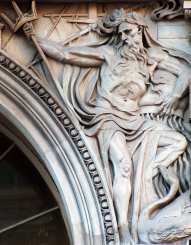 Neptune in Northumberland Avenue
Neptune in Northumberland Avenue
At end of this bit of the gardens is Northumberland Avenue, which leads through to Trafalgar Square. A minute’s diversion along here can be made to see very fine sculpture on a building on the left hand side, signed by HH Arms which must be Armstead. Fine spandrel figures of Neptune, in front of a ship, with one corner of the Tower, and a woman who might be Britannia, with behind the dome of St Pauls, Big Ben and the flag of St George.
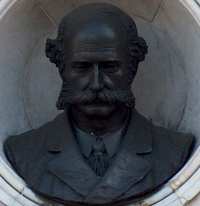 Bazalgette Memorial, by George Simonds
Bazalgette Memorial, by George Simonds
Back to the Embankment and opposite the entrance to Northumberland Avenue, on the river wall, is a plaque to Bazalgette by George Simonds. Simonds made one great monument, and this is not it – a huge snarling lion in Reading; the Bazalgette is important because as we said, it was he who built the Victoria Embankment, but despite the lowered mighty brow and penetrating gaze, this portrait, with bald head and handlebar moustache, conveys some dignity but not greatness. Bazalgette lived in his later years in Wimbledon, and at the church there is his grand tomb, and a monument - see this page.
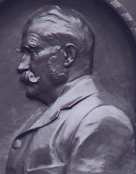
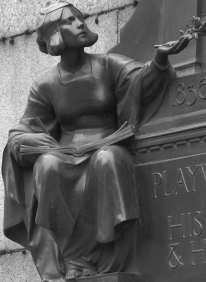 WS Gilbert, and figure of Tragedy, by Frampton
WS Gilbert, and figure of Tragedy, by Frampton
Just the other side of the railway bridge (Hungerford Bridge, often called Charing Cross bridge), flanked by the two elegant Golden Jubilee footbridges, a further plaque, of WS Gilbert. This is the first of three panels we shall see by George Frampton, a vital figure in the New Sculpture Movement, and on this one, as is typical with the artist, the portrait is flanked by tiny allegorical figures– Tragedy and Comedy here, most charming. If you like the Gilbert, wait for the Sullivan a little further on.
Standing by the Gilbert Monument, directly opposite we can see on the other side of the road the pediment of Embankment Station– a rather arts and crafts girl in symbolist pose, with two hulking heraldic beasts holding shields in their sharp claws: no sign of a signature.
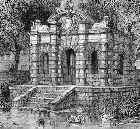 Buckingham Gate, north side of Thames, 1830
Buckingham Gate, north side of Thames, 1830
Crossing back over the road, we can enter the main Embankment Gardens. A series of statues here, but first though we note the Buckingham Water Gate, by the architect Balthazar Gerbier (1626-7), marking the old northern bank of the wider, shallower river before the Embankment was built. There are two lions on top, utterly decayed (see this page for lots of lion sculptures). Our first Victorian statue is the huge Robert Burns by John Steell, one of three versions (the others are in Dundee and Central Park, New York, where there is also his Walter Scott). Most impressive, epic and heroic. Behind is the 1930s face of the New Adelphi building with four large stone figures in relief at the corners, by Gilbert Ledward and others, stylised and deco. Across the road almost opposite is Cleopatra’s Needle – we’ll come back to this.
Close by Burns – unfortunately so because by comparison it is incongruously small and delicate –is the Imperial Camel Corps memorial, one of several sculptural depictions of the camel in the capital. The sculptor was Cecil Brown, not so well known, who had a military as well as artistic career, and seems not to have produced that much. Next is David McGill’s Wilfred Lawson, standing, bearded, nothing special, by an artist who has done much better things. Alas, there seems to have been 4 allegorical girls around the base, but they are gone.
Then a panel to Henry Fawcett above a little granite fountain, by Mary Grant, who was the niece of Sir Francis Grant, the American president of the Royal Academy. The portrait, unusually has closed eyes, so appearing rather saintly, and what little else I have come across by Mary Grant is indeed ecclesiastical work.
Next comes Thomas Raikes, founder of Sunday Schools, which is a second work by Thomas Brock. Wigged, waistcoated and rather paunchy, and not a patch on the Bartle Frere.
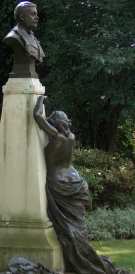 Sullivan Memorial, Goscombe John
Sullivan Memorial, Goscombe John
Then one of the real treats of the walk, the beautiful Sullivan Memorial – outstanding work by Goscombe John. The statue of a grieving girl (an allegorical figure of Music) collapsing against the stele below the portrait of the playwright is one of my favourite works in London, and associates the sculptor firmly with the New Sculpture movement. He did in fact create a goodly selection of art nouveauish girls, though nothing else so ambitious as this, which might surprise those most familiar with his multitudes of fairly conventional outdoor statues of middle aged men, particularly in Wales which he carpeted end to end with his statues. He incidentally did another Sullivan memorial (a plaque with a portrait, an image of St John the Baptist, and a couple of putti) for St Paul’s.
At the end of this stretch of the Embankment Gardens, just outside the green space, at the corner with Savoy Place (which leads through to the Strand), is an appropriately dignified and intelligent Faraday, reproduction of a marble statue by J.H. Foley.
We need to double back on the outside of the main Gardens, to see Cleopatra’s needle and the huge sphinxes. The possibility of bringing Cleopatra's needle from Alexandria to England first arose in 1862, as one of several ideas for a memorial to Prince Albert. Thomas Thornycroft was one of many who objected to this idea on the grounds that Albert believed that ‘our public monuments should be in art the expression of our present condition and civilisation’ so that the Needle would be a poor monument of the 19th Century. Similarly, M. Hennin, the French author of an important book on the monuments of Ancient Egypt, objected to the obelisk taken to Paris and placed in Place de la Concorde. Anyway, the enormous obelisk did eventually come to England in 1877. By the Needle are excellent sphinxes, designed by G. J. Vulliamy, and like the the dolphin lamps, modelled by CH Mabey. Views from here of St Paul’s and the steeple of St Brides, before the approach to Waterloo Bridge cuts these off. The needle marks the centre of a near 90 degree change in direction of the river, which previously was running north, with Whitehall one block behind the Embankment and slightly divergent, and now turns due East, with the Strand now a block or so away.
Facing the Needle across the road - you can see only the back from within the Gardens - is the Belgian World War I monument, with a bronze group by V. Rousseau (1917-20), very much in the idiom of the period, and two limestone classical relief sculptures, very weathered. The architect was again Reginald Blomfield.
On again, to the end of the main gardens where we were with Savoy Place, and opposite against the Embankment wall, another plaque, to Walter Besant, our second by Frampton, with arts and crafts border, but unfortunately no allegorical girls.
Next, under the bridge, which is Waterloo Bridge, we come to the vast bulk of Somerset House, housing the Courtauld, Witt and Conway, the Barnes Collection and an outcrop of the Pushkin, as well as the Inland Revenue. Crossing back to the river side, along with lions and keystones, we can see the river-facing pediment of Somerset House, designed in the late 18th century by the totally unfamiliar Richard Rathbone, the central figure apparently representing Amphitrite – we show this as our picture, because you will need binoculars to appreciate otherwise.
 Somerset House pediment, towards the river
Somerset House pediment, towards the river
Next we face Brunel on a bulky Portland Stone edifice by the entrance to Temple Place. Marochetti was the sculptor, and the surround is by Norman Shaw. Brunel is wearing a frock coat, and stands in an easy pose, with quizzically raised eyebrow. Marochetti has several works in London, including especially Lord Clyde in Waterloo Place, the one with the Britannia in the fetching mail shirt, seated on a lion.
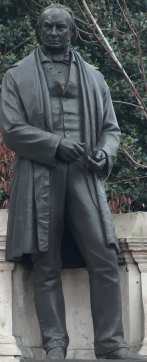 Isombard Kingdom Brunel, by Marochetti
Isombard Kingdom Brunel, by Marochetti
Opposite on the Embankment Wall is another plaque, to WT Stead, who went down with the Titanic. This is our third and final work by Frampton, dates from 1913, and has little figures of Fortitude and Sympathy.
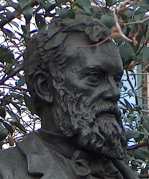 W.E. Forster, by Henry Richard Hope Pinker
W.E. Forster, by Henry Richard Hope Pinker
Then we enter the last bit of the Gardens, to see WE Forster, by Henry Richard Hope Pinker, which seems a bit prosaic, but is pictured here because it is one of only a very few works by this sculptor I have seen (others are in Salisbury and Oxford).
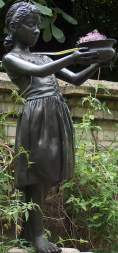 Temperance, Lady Somerset, by G.E. Wade
Temperance, Lady Somerset, by G.E. Wade
Next, another excellent work, a bronze statue of a young girl with a bowl, representing Temperance, for Lady Somerset. The sculptor was G.E. Wade. The panel beneath reads ‘From children of the loyal Temperance Legion in memory of work done for the temperance cause by Lay Henry Somerset, the President, National British Women’s Temperance Assoc, incorporated June 1896 I was thirsty and ye gave me drink’
Woolner’s statue of John Stuart Mill completes this section of the gardens, seated, rather ascetic, understated in the way Woolner tended to – not Pre-Raphaelite, except in the Ruskinian sense of truth to nature.
Next is Temple itself. On to the railings of the Temple Inn, where at the beginning is a marble panel commemorating the last visit by Victoria to the area, with a worn profile by C.H. Mabey, not atypical of several modest works by this sculptor, with whose work we are acquainted from the Cleopatra's needle sphinxes noted above.
On river side, the huge George V arch, designed by Bazalgette himself (1868), with two lively cherubs on ship prows, and enormous keystones facing inwards and outwards to the river (for a picture of the Arch, and one of the keystones, see the page of keystones). A little way along on the wall is the Navy Submarine memorial – a plaque flanked by 2 small figures, signed by F Brook Hitch 1922.
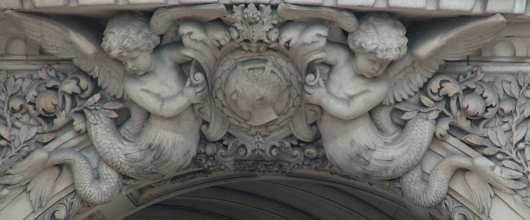 Temple mer-cherubs, by Calder Marshall
Temple mer-cherubs, by Calder Marshall
Then the garden and grand Embankment-side entrance of the Temple, a work by the architect E.M. Barry dating from the late 1870s. The sculptural work is by William Calder Marshall, and includes two full figures, various half figures higher up, and little heads in roundels. I rather like the mer-cherubs in the keystone position of the doorway.
The final bit of the Embankment is grimly close to the speeding cars, but important. Despite its lack of sculpture, we must note Sion College, a distinctive Gothic churchlike edifice, in brick, by the architect Arthur Blomfield (1886).
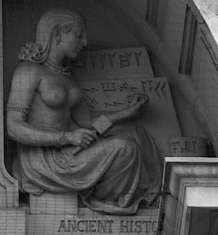
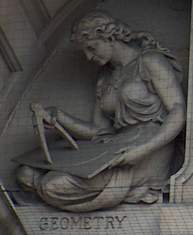 Learning ancient history and geometry with J. Daymond & Son
Learning ancient history and geometry with J. Daymond & Son
Then a final highpoint, the former City of London School building, with full sized statues of Francis Bacon, John Milton, Isaac Newton and William Shakespeare, with Thomas More round the side, all by J. Daymond & Son. Also pairs of allegorical girls in the best taste, showing the different subjects of study. Much minor stone carving including virtuoso floralities. The architects of this Renaissance triumph were Davis and Emanuel (1881-2)
We end at about Blackfriars Bridge with a few more things. The Queen Victoria is by C.B. Birch. The bridge itself has capitals by J. Birnie Philip showing birds, easily missed, but worth examination. Birnie Philip is familiar, of course, from his work for the Albert Memorial.
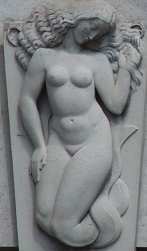 Mermaid keystone on Unilever House
Mermaid keystone on Unilever House
The great curving bulk of Unilever House bears more modern sculpture from the 1930s – a pair of huge horses pulled by nude figures by William Reid Dick, and smaller works by Gilbert Ledward, including a series of figures on the top balustrade which unfortunately were removed, apparently for cleaning and restoration, and never replaced, and the nice keystone mermaid shown here.
It is possible to make a small exploration of roads doubling back behind Unilever House, to see more minor and unattributable sculpture, through to Temple Avenue wherein may be seen a pair of rather fierce warriors supporting a doorway, and decorative girls in high relief.
Back at Unilever, the main road is New Bridge Street, and takes us to the end of the walk at Blackfriars station, passing by the charming Wills Brothers Fountain close by the entrance, and with opportunity to see across the road the Black Friar tavern.
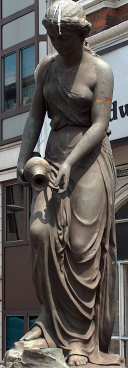 The Wills Fountain, by Blackfriars tube station
The Wills Fountain, by Blackfriars tube station
At Southern end, to Westminster Bridge // or West to Whitehall
At Embankment, go West to Charing Cross // or to Trafalgar Square // or along the Strand
By Somerset House, go North through to Aldwych // At Eastern end, to Blackfriars Bridge
Eastwards to St Benet's Paul's Wharf
London sculpture // Sculpture pages
Visits to this page from 13 Mar 2014: 10,704